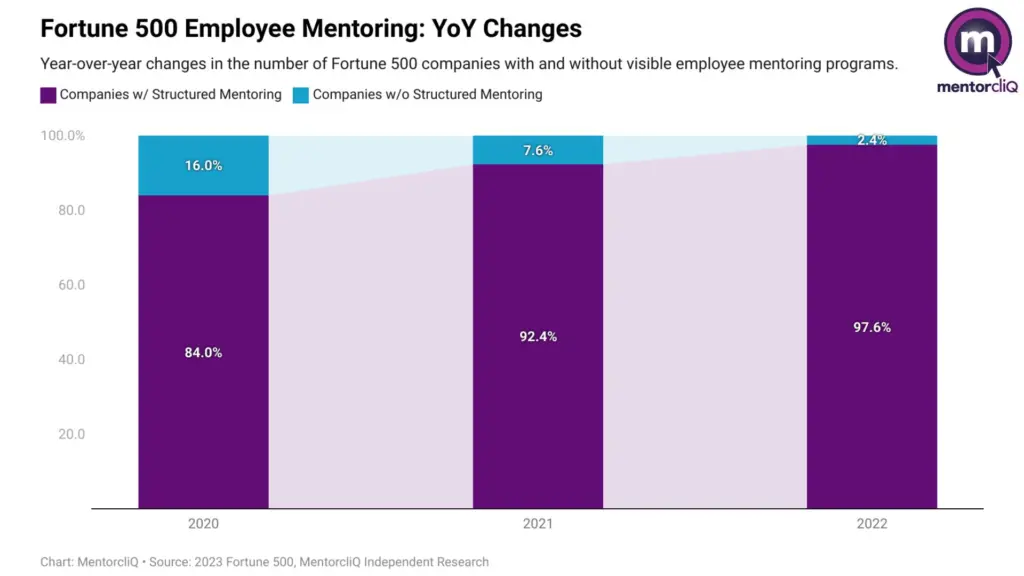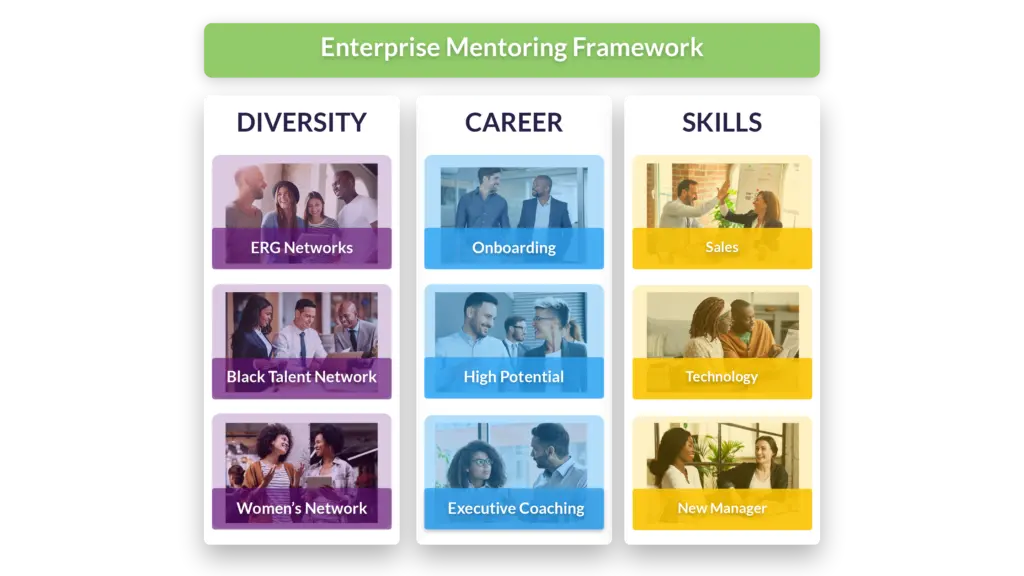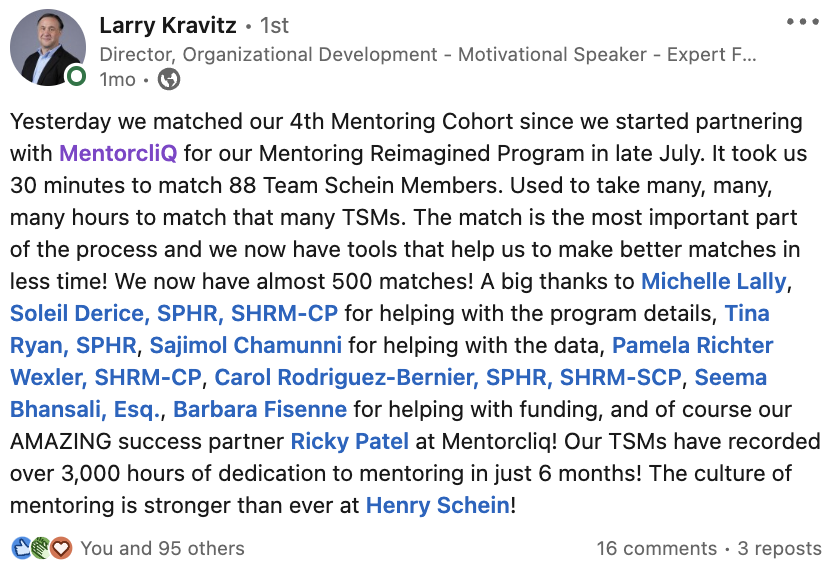Corporate mentoring has always been essential, but as with all people strategies, time changes what does and doesn’t work. Changes in both employee dynamics and the socio-economic environment have led to shifts in employee engagement, development, and retention in corporate settings.
In a corporate setting, mentorship programs are often the most effective tools for employee engagement, professional development, skill enhancement, and career advancement within the company. However, your approach may need an upgrade to match both generational differences in learning and expectations, as well as societal and cultural shifts, and significant advancements in learning technologies.
By following a few mentorship program best practices applied through a corporate lens, you can build mentoring programs that people actually want to participate in and that yield the kind of results that executive leaders will proudly share with investors, shareholders, and just about anyone who’ll listen.
This article will give you some insight into building and maintaining effective corporate mentorship programs, including:
- Why you should launch corporate mentorship programs in 2026
- Implementation strategies
- Recommendations on how to measure success
Whether you are an HR or talent development leader considering implementing a mentorship program or an employee interested in participating, this article will provide valuable insights.
Top Strategies for Corporate Mentoring in 2026
Navigating employee development and engagement at the corporate level involves looking forward, not backward. That means planning for the future of work by following the right trends. In the coming year (and over the next decade), the most important workforce development strategies that can be enhanced by mentoring include the following:
1. Focus on upskilling employees for requisite skills
Upskilling is going to be one of the most critical strategies that companies can deploy in 2026 and beyond. The skills landscape is changing, with dramatic shifts toward AI skills. Many companies in the corporate sector are now giving employees an ultimatum: upskill in AI, or be left behind.
In fact, in September 2026, Accenture’s CEO Julie Sweet explained that the company plans to “exit” employees who cannot be upskilled in AI. “Can’t” is the operative word here. Accenture doesn’t plan to start massively laying off every employee that “seems” like they can’t be upskilled. Instead, the company expects its employees to “retrain and retool” at scale.
As noted by CNBC:
“We are investing in upskilling our reinventors, which is our primary strategy,” Sweet said. She explained that the company is “exiting on a compression timeline” people for whom reskilling isn’t a “viable path.”
Upskilling is not just a matter of teaching people a skill. It’s about showing them how to utilize that skill in practical ways that benefit the organization within their own role. For that, mentoring is needed, particulaly where the skills being learned relate to valuable internal knowledge that must be passed on for future company success.
Scaling mentoring across an organization is no easy task, but it can be done successfully through mentoring software designed to automate matching and program management (e.g., MentorcliQ!).
2. Bridge generational gaps in learning and experience
Generational gaps in the workforce are increasing at an unprecedented rate. The difference in workforce experiences and workforce expectations among the oldest workers (Boomers) and the youngest workers (Gen Z) could not be wider.
An early 2025 post in the Reddit group /r/managers highlighted some of the biggest generational differences, particularly among the oldest and youngest set of workers:
Have you noticed any discernible differences in the work ethic/culture of the supposed “generations”?
byu/Mindofmierda90 inmanagers
That this post drew hundreds of comments and upvotes is telling. And it speaks to the exigency of this topic. Every generation appears to have differences in expectations in the workforce, but Gen Z workers, in particular, often feel overqualified and underpaid.
This can cause Gen Z workers to feel disconnected, discontent, and unappreciated.
According to Purdue Global, Gen Z workers have a unique perspective:
- 67% of Gen Zers want to work at companies where they can learn skills to advance their careers (survey data the National Society of High School Scholars)
- 65% of Gen Zers believe employers should let them learn on-the-job through internships or apprenticeships (survey data from ECMC)
The clall here is simple: If you want to attract and keep Gen Z workers, you need to find creative ways to ensure they can learn quickly on the job, instead of being expected to come in with knowledge and skills that they couldn’t acquire due to limited entry-level roles.
(Note: You have no choice here. Gen Z is eventually going to be the largest subset of workers. The fight for talent starts early, and companies that create learning pathways for young workers will win that fight.)
3. Increase development opportunities for managers
It’s no secret that socio-political and economic environments have had a profound (read: negative) impact on employees across the board.
In the 2025 edition of its State of the Global Workplace report, Gallup found that few roles are free from the impacts of what’s going on around us.
- Global employee engagement fell to 21% in 2024 (from 23% the previous year) with signs of dropping further this year.
- Manager engagement fell to 27% in 2024 (from 30% the previous year)
Gallup notes that a more granular look at the data finds more troubling trends for managers, in particular:
No other worker category — male or female, young or old — experienced as significant a decline.
However, two types of managers were particularly affected: Young (under 35) manager engagement
fell by five percentage points; female manager engagement dropped by seven points.
If your managers are struggling, your teams are struggling. It’s a downstream effect that you can’t improve until you improve how well your managers are leading their teams. This can be accomplished through giving them what they need: manager-specific engagement, development, and connection. Creating mentoring programs that are manager-focused and built on those three principles will help boost productivity across your organization.
Why Implement a Corporate Mentorship Program in 2026?
Corporate mentorship programs are now a standard approach. In our 2024 Mentoring Impact Report, we found that 98% of U.S. Fortune 500 companies now have mentoring programs. That marked an eight percentage point increase year-over-year, and well above the 70% that was highly cited from a 2005 research paper.

Large and publicly traded corporations are increasingly leveraging mentoring as a critical part of their employee development and engagement strategies. But why? Well, that “why” is pretty clear when you look at how much money they’re saving even with small, targeted programs for specific populations, such as sales teams.
For example, companies using MentorcliQ’s mentoring software typically see the following results among program participants:
- An average 32% decrease in employee turnover
- A 2X increase in mobility and promotions

That was absolutely the case for renowned microchip maker AMD. Running nearly a dozen programs that leverage MentorcliQ’s mentoring software, AMD has achieved a 32% reduction in employee turnover among those enrolled in mentoring programs. Its Career Development Program is among its most popular, with thousands of participants enrolled in 9-month relationships designed to help them develop long-lasting career development strategies.
(Want to know more? Book a demo to see just how they worked that magic!)
Large mentoring programs reap the most rewards
For mentoring programs with 100 or more participants, the savings are fairly impressive:
- $550K in annual retention savings
- A 40X mentoring ROI
Note that annual retention savings can quickly get into the millions of dollars, depending on how many additional employees you retain. You can check out our ROI calculator to learn more, but the back-of-napkin math is to typically consider the cost to replace an employee at 1.5 to 2.5 times that employee’s salary. With the median salary now at around $70,000, you can see how that adds up quickly.
Of course, not every company is seeing those results. Simply having corporate mentorship programs is not the same as having effective corporate mentorship programs.
What often happens is that organizations (yes, even some of the largest ones out there) will launch manually-run mentoring programs that are limited in scope and impact. Instead of scaling with mentoring software, these programs are often put into the hands of overworked and stressed-out HR and talent development leaders who do what they can with their limited resources.
It’s hard to make mentoring as impactful as possible when you aren’t using best practices that increase participation rates, expand the number of programs you can offer, and make results easy to track and quantify.
That “why” section is pretty extensive, but it matters. If you’re trying to expand mentoring at the corporate level, you’ll need that data and other mentoring stats to build the case for executive leaders. From there, you’ll also want to establish what to target in those programs to get the best results.
5 Key Focus Areas for Corporate Mentorship Programs
Let’s say you’re starting or expanding your mentoring program for a corporation. Typically, we’re talking about an enterprise company (though not always), so you’ll need to plan how to make mentoring work with a larger population. You will also want to target the needs of as many workers as possible (at least to start), which directly impacts organizational goals.
Here are five strategies that will likely suit you well.
Skill development
One of the primary goals of corporate mentorship programs is to facilitate skill development. Mentors guide mentees in identifying strengths and weaknesses, setting goals, and developing specific skills. This tailored approach ensures that employees receive the support they need to grow professionally.
Multiple types of programs will help you offer skill development for corporate employees. Functional mentoring programs are a highly-targeted approach. And where you have mentees at different skill levels and a limited number of mentors, mentoring circles or group mentoring can be a great solution.
Employee retention
As we noted earlier, mentorship programs tend to have a very positive impact on employee retention rates. By providing a supportive environment and opportunities for personal growth, employees are more likely to remain committed to the organization. This not only reduces turnover costs but also helps in building a loyal and engaged workforce.
To that end, consider targeting your mentoring programs around specific populations with higher-than-average turnover. For example, perhaps your company has a hard time keeping new hires. You can enhance the new hire experience with an onboarding mentoring program that pairs new hires with more experienced team members who can help ease the type of early anxieties and frustrations that lead to early turnover.
Leadership development
Developing future leaders is a strategic priority for many organizations. What’s more, leaders are most effective when they’re developed and promoted from within instead of hired externally. Corporate mentorship programs should provide that framework to help take high-potential employees through that journey, from early identification of employees with leadership potential to continued mentoring after they’re promoted.
Companies should also consider the value of having executive mentoring programs, as well. C-suite turnover is increasing. The cost to replace an executive is generally higher than that of a junior-level employee, both in the salary difference and the multiplier. While junior-level employees may cost 1.5 to 2 times the salary, executives often cost up to 3 times their salary to replace.
Depending on how your company is structured, you may need to have multiple programs targeting leadership development in various ways.
Enhancing company culture
Corporations often struggle to get their culture right. Many also view remote work as a hindrance to creating a strong and cohesive culture (hint: it’s not!). Mentoring programs are a great way to normalize and spread company culture in an authentic way.
Corporate mentorship programs can foster a culture of collaboration, trust, and mutual respect. They can help break down hierarchical barriers and encourage open communication. This positive impact on company culture can lead to a more harmonious work environment and increased productivity.
Beneficially, most mentoring programs can be avenues for positive company culture. Additionally, when you pair mentoring within Employee Resource Groups, you can add an extra layer of connection to the company and the benefit of understanding and adopting its broader culture (and subcultures).
Types of Corporate Mentorship Programs that Work
Here’s a not-so-secret secret of corporate mentorship: any type of program will work. The type of mentoring program you use is less important than making sure you cover the two most important questions about that program:
- Purpose: Why do you need this program? What problem is it trying to solve?
- Population: Who is this program going to involve? What are their needs, and what will they get out of it?
Answering those two questions will help you land on the right type for the right population that impacts the right company goals.
Here are a few types that you may want to consider:

- Traditional mentorship: The most common form, where a seasoned professional mentors a less experienced employee. This one-on-one relationship fosters personal and professional growth, helping the mentee navigate their career path with the guidance of a skilled mentor.
- Reverse mentorship: An innovative approach where younger employees mentor senior executives on emerging trends, technologies, and cultural shifts. It’s a reciprocal learning experience that bridges generational gaps and fosters a more inclusive culture.
- Group mentorship (including mentoring circles): In group mentorship, a single mentor guides a group of mentees. It promotes peer learning and collaboration, offering a diverse perspective and shared learning experience.
- Peer mentorship: A more informal structure where employees mentor each other at the same organizational level. It’s a mutually beneficial relationship that encourages empathy, understanding, and shared growth.
The types of programs you might offer, generally speaking, are usually broad. The specificity is usually more aligned with the population and purpose of the program. For example, you can use a traditional 1:1 mentoring program type for affinity-based mentoring, career development, onboarding, skills development, etc. Or, you could use a circle or group approach. Many additional variables will impact which programs make sense for your corporation to launch.
Once you’re ready to launch or expand a corporate mentorship program, you may want to work within a framework that establishes and formalizes the structure.
How to Create a Successful Corporate Mentorship Program
Now that you know why corporate mentoring programs are valuable and what they could look like, let’s talk about the building process. The more bureaucratic structure of a corporation means you’re going to have to go through multiple layers to get the program launched or expanded (and by “layers,” we mean “sometimes hard-to-please stakeholders”).
Here are some tips to begin the planning process. There’s also a video at the end that will expand on this advice.
1. Identify program goals
Creating a successful corporate mentorship program begins with identifying clear and measurable goals. What do you want to achieve with the program? Whether it’s fostering leadership skills, enhancing employee engagement, or boosting productivity, having well-defined goals provides direction and focus.
You can ensure that the program supports overall business success by aligning mentorship goals with the corporation’s broader objectives.
2. Selecting participants
Choosing the right participants is critical in building a robust mentorship program. Mentors should have the experience, expertise, and willingness to guide mentees, while mentees should have a clear desire to learn and grow.
A well-matched mentor-mentee pairing can lead to a rewarding relationship that benefits both individuals and the organization. Consider implementing a matching process that considers interests, skills, career goals, and personalities to create meaningful connections.
Not sure what mentor matching is all about or how to match effectively? Book a demo to see why MentorcliQ’s matching algorithm is often the linchpin for switching to mentoring software.
3. Training and guidelines
Training for mentors and mentees is essential to set expectations and establish guidelines. Your training sessions can cover topics such as:
- Communication skills
- Goal-setting
- Confidentiality
- Constructive feedback
- DEI
We typically recommend mentors and mentees begin by agreeing to what that engagement will look like and using a mentoring agreement to set that in writing.
Offering resources and support throughout the program ensures that participants have the tools they need to succeed. Additionally, clear guidelines and a code of conduct help maintain professionalism and integrity within the program.
As much as possible, avoid assuming that your mentors or mentees know how to serve in their individual capacities. Mentors often need training, and mentees often need some guidance on what it means to take ownership of their development.
4. Monitoring and evaluation
Ongoing monitoring and evaluation are vital to assess the effectiveness of the mentorship program. Regular check-ins, surveys, and feedback sessions allow you to gauge progress, identify challenges, and make necessary adjustments.
Tracking key performance indicators (KPIs) related to the program’s goals provides quantitative insights into the program’s success. Celebrating achievements and recognizing participants’ contributions fosters a positive culture and encourages continued participation.
A well-designed and thoughtfully implemented corporate mentorship program can be a transformative tool for both individual development and organizational growth. By focusing on goal alignment, participant selection, comprehensive training, and continuous evaluation, you lay the foundation for a thriving mentorship culture within your company.
Common Challenges with Launching and Running Corporate Mentorship Programs
Unless you’re living in an ideal world of magic, fairies and unicorns, your mentorship program isn’t likely going to be perfect. You will hit roadblocks and challenges at pretty much every step of the way and even well after your programs are off the ground. Taking time to understand what might happen will help you prepare for those issues ahead of time.
We offer some insights below, but we highly recommend you attend our FREE MentorCliQ events. MentorcliQ clients who’ve successfully launched and managed programs offer their insights on how they navigate the biggest challenges that come with running mentoring programs at the corporate level.
1. Matching mentors and mentees
Finding the right match between mentors and mentees can be a complex task. Many companies try to start with a manually run program and try to leverage spreadsheets and guesswork to match. That’s often the wrong approach because it’s horribly unscalable but introduces significant unintentional bias into the matching process. Results tend to be less than ideal, to say the least.
2. Time commitment
Mentorship requires time and dedication. Organizations can overcome this by setting clear expectations and providing flexible scheduling options. What’s more, managing programs is going to take time and commitment. Many program managers or stakeholders underestimate how much time it takes to do just about everything involved in setting up new programs. Matching alone can take dozens of hours if you’re trying to use a manual approach.
One of our favorite stories of how a company solved the time commitment and matching problem comes from MentorcliQ client Henry Schein:

3. Measuring success
Determining the success of a mentorship program requires careful planning and evaluation. Implementing regular feedback sessions and tracking progress through quantifiable metrics can address this issue. You can’t measure if you don’t know what is important, so measurement should start with the end in mind and be tied directly to corporate goals that can be measured (such as retention, promotions, and mobility).
4. Addressing failures
In 1785, Scottish poet and farmer Robert Burns wrote a lyric that’s been a part of the English canon ever since:
“The best laid schemes of mice and men / Go often askew / And leaves us nothing but grief and pain, / For promised joy!”
It doesn’t matter how strategically you plan out your mentoring programs. Something is bound to go wrong. And that’s OK. When you’re working with both humans and technology, nothing is ever perfect. Having a process in place to recognize and address failures will help you get over those issues quickly.
An excellent example is having feedback surveys automatically sent to participants on a schedule. You can get an early warning sign that a mentor-mentee relationship or program design isn’t working and adjust accordingly before everything implodes.
What Will Your Corporate Mentorship Program Look Like?
Corporate mentorship programs are essential in the modern business landscape, offering benefits like skill development, employee retention, and leadership growth. Whether it’s traditional or virtual mentorship, these programs can significantly impact an organization’s success.
If mentoring is on the radar for your corporation, now’s the time to start! That starts with booking a demo to understand better how mentoring software can get your programs launched and ready in much less time.




